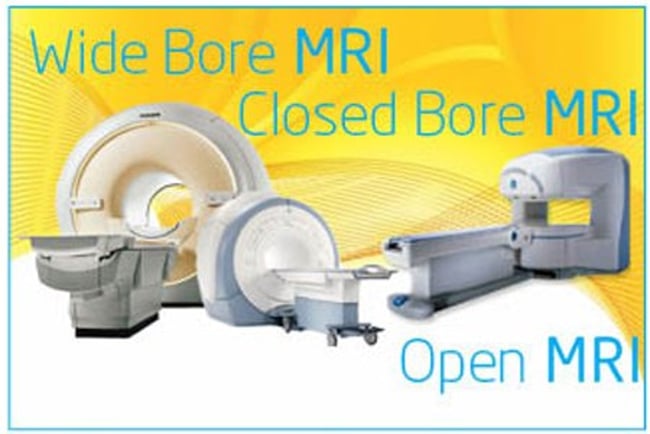As a health care professional or administrator it’s important to know the difference between the various types of MRI equipment. However, before we jump into the differences, let’s examine the basics. MRI is an acronym that stands for Magnetic Resonance Imaging. Most of these complex machines are commonly  referred to as “MRI” or “MRI scanners,” regardless of the type of specific MRI equipment being referred to. Please check out our INFOGRAPHIC HERE on MRI Differences too!
referred to as “MRI” or “MRI scanners,” regardless of the type of specific MRI equipment being referred to. Please check out our INFOGRAPHIC HERE on MRI Differences too!
An MRI scanner is a very large piece of diagnostic imaging equipment that is used in radiology and medical imaging to investigate the anatomy and physiology of the body. They have a wide range of applications. Inside each MRI scanner is a very large magnet of varying strength. These different strength magnets are measured in Teslas or “T”. The MRI scanner uses a combination of magnetic fields and radio waves to form diagnostic images. During the MRI procedure the patient is required to lie very still while the MRI magnet and radio waves scan the body. Software inside the MRI machine converts the signals into highly detailed images that medical staff can use.
MRI scanners come in varying sizes and configurations:
Closed Bore MRI
Close Bore MRI are usually high field systems that have excellent image quality, speed and a magnet strength ranging from 1.0T to 3.0T. During a Closed Bore MRI procedure patients lie flat and are inserted into the opening in the MRI scanner. The feeling is like being in a narrow tunnel and being completely surrounded. This is the main drawback with Closed Bore MRI machines. The “bore” or area where the patient is scanned has the smallest opening, around 60CM.This can make many patients feel claustrophobic and many larger patients simply cannot fit.
Open MRI
As the name implies the Open MRI is open on three to four sides depending on manufacturer and model. Prior to the introduction of the Open MRI low field system, larger patients were simply not scanned because they couldn’t fit inside the bore of the machine. This improved accessibility is the primary advantage of the Open MRI. It allows larger framed, obese or claustrophobic patients to be scanned comfortably.
Allowing for more space in the Open MRI scanner does have its own drawbacks. The magnet size in Open MRI scanners starts at .35T to .7T and currently tops out around 1.2T. The result is reduced image quality when compared to Closed Bore MRI. Open MRI is best used on the extremities (knee, shoulder) rather then the torso, organs or skull. In addition to image quality, another factor to consider with Open MRI systems is time. It takes roughly one and a half to two times longer to produce a comparable image.
Wide Bore MRI
Wide Bore MRI is also referred to as Open Bore. It combines the benefits of Closed Bore MRI with more space inside the bore area of the machine. The Wide Bore MRI system delivers both high magnet strength, high quality imaging and the procedure is shorter in duration than an Open MRI. It is ideal for larger patients and patients that would otherwise get claustrophobic because it has a 70cm opening. The Wide Bore MRI is roomier inside which means a lot more people are willing to take the scan. Wide Bore MRI systems often provide an economic benefit to hospitals and imaging centers because patient preparation time is reduced, comfort is increased, image quality is high and more scans can be conducted during operating hours.
Comparing the Strength of an MRI
Let’s say:
- A .35T magnet is a Nissan Maxima
- A 1.5T magnet is a Audi A5
- A 3T is a Maserati.
The Maserati is clearly in a league of its own but is not practical for all purposes (can’t put more than two people in it, can’t carry any luggage, goes so fast you might get into an accident or a ticket, sits too low to the ground, etc.).
The Audi A5 and the Nissan Maxima are similar to each other but the Audi has more features, a better reputation and more advantages. If you were offered a brand new fully loaded car, which would you prefer?
Choosing an MRI System
Today the 1.5T is considered the standard MRI in a clinical setting. One benefit is that a 1.5T is ideal for abdomens and chests scans where a patient is asked to hold their breath since it is faster than lower strength MRI machines. There is more signal with a 1.5T magnet so you can run shorter times and have higher image quality.
As you can see there are many factors involved in the choice of Closed Bore MRI, Open MRI and Wide Bore machines. High field no longer means better images while Open technology continues to improve. You can achieve great images by setting up proper parameters and protocols based on the MRI you chose.
If you have any questions please contact our expert team at Atlantis, we can guide you through the process!
Please contact us for any questions on used MRI systems.
Some blogs you may have missed:
- How Does an MRI Work?
- Before You Order That MRI: A Checklist
- Top 4 Considerations Before Installing an MRI
- 8 Channel MRI vs. 4 Channel MRI—What is the Difference?
- The Growing Need for MRI in Veterinary Medicine




